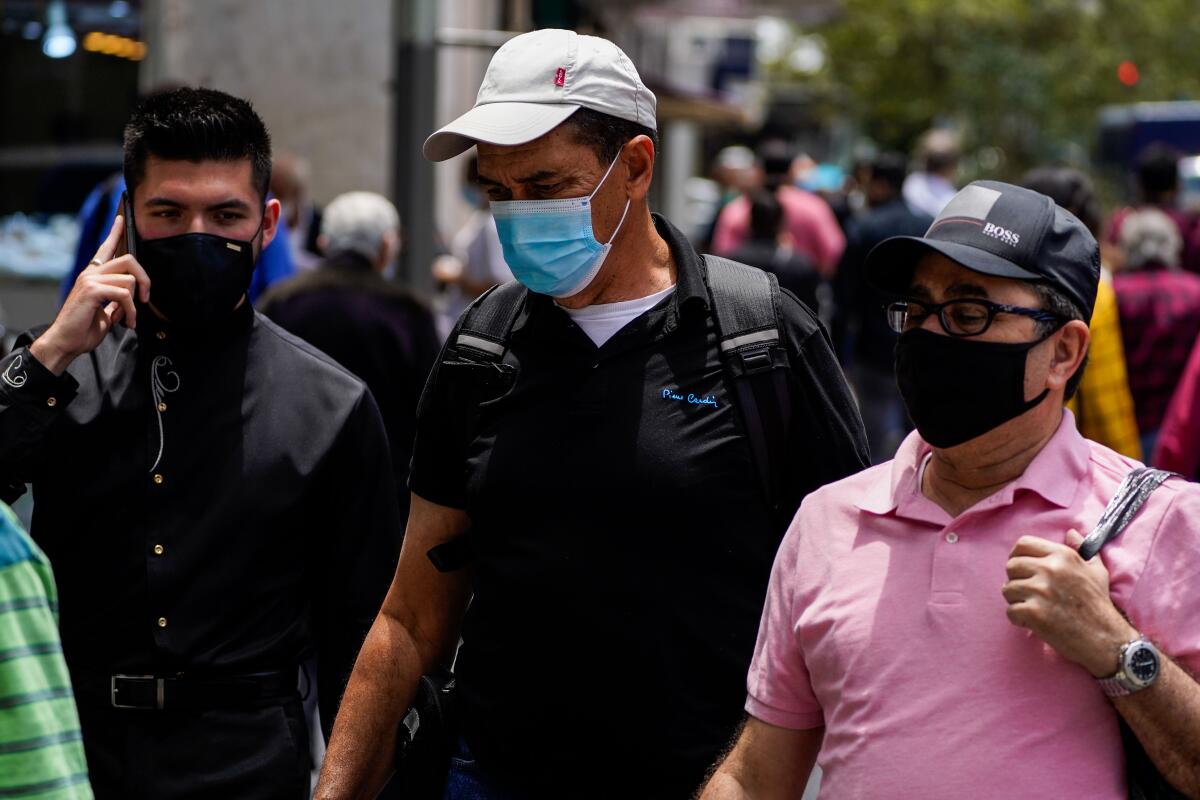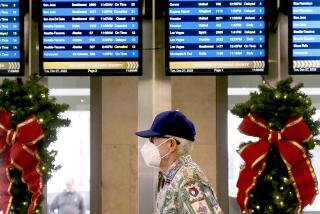L.A. County issues dire warning amid ‘alarming increases’ in coronavirus cases

- Share via
Los Angeles County health officials issued a dire warning Monday that conditions amid the COVID-19 pandemic are deteriorating rapidly and the highly contagious virus is spreading swiftly in the nation’s most populous county.
They said they are now faced with one of their biggest fears: that the reopening of L.A. County would coincide with sudden jumps in disease transmission that have the potential to overwhelm public and private hospitals.
L.A. County has long been the epicenter of the coronavirus in California — with nearly 98,000 confirmed cases and more than 3,300 deaths — but officials said Monday that the outbreak is worsening.
Barbara Ferrer, the director of public health for L.A. County, said that new data show “alarming increases in cases, positivity rates and hospitalization.”
“This does indicate — definitively — that we have increased community transmission,” Ferrer said. “There’s so much at stake, since these continued increases will result in many more people becoming seriously ill, and many more deaths of COVID-19.”
“This is the time to hunker down back in your home whenever you can,” Ferrer said, urging people to wear their masks and practice social distancing. “Please, let’s not let go of everything we worked hard and sacrificed for.”
She urged people to avoid crowds. “It’s just not safe right now,” she said.
The L.A. County Department of Public Health also announced a ban on fireworks displays.
“We’re seeing more people get sick and go into the hospital. This is very much a change in the trajectory of the epidemic over the past several days. It’s a change for the worse and a cause for concern,” said Dr. Christina Ghaly, L.A. County’s director of health services.
The daily number of new coronavirus cases that require hospitalization could be four to five times the peak of what L.A. County saw in late March and early April, “placing tremendous burden on our healthcare system and hospitals and resulting in much otherwise unnecessary suffering and mortality,” Ghaly said.
With a predicted increase in hospitalizations, for the first time since the coronavirus crisis seemed to ease locally, L.A. County is now projecting the possibility of running out of hospital beds in two to three weeks. Likewise, the number of intensive care unit beds could be exhausted sometime in July.
If the increased disease transmission rate continues as it has done so over the last few weeks, it “suggests that we are at risk of running out of hospital beds if we don’t take steps to increase that capacity within the next two to three weeks,” said Dr. Roger Lewis, a biostatistician, director of the COVID-19 demand modeling unit for L.A. County and chair of the emergency department at Harbor-UCLA Medical Center.
“We did anticipate that we would see increases in cases of hospitalization. The problem was that we didn’t expect to see increases that were this steep so quickly,” Ghaly said.
Los Angeles County confirmed 22 additional coronavirus-related deaths and 2,903 new coronavirus cases Monday.
The county is able to meet hospital demand currently, but many of the patients who have already been exposed to the virus will now be filling the beds in the coming weeks. It can take three to four weeks after exposure to the virus for infected people to become sick enough to be hospitalized, and four to five weeks after exposure for some of the most vulnerable patients to die from the disease.
“So even if steps are taken immediately to reduce the spread in the community, we do expect to see a continued uptick in the next two to four weeks,” Lewis said.
All public and private hospitals in L.A. County need to be prepared to treat more patients based on these projections, Ghaly said. Hospitals can create new capacity by reducing elective procedures and surgeries and take steps to expeditiously discharge patients who no longer need hospital care.
Hospitals can also add more beds beyond their normal licensed capacity, typically 20% to 40% over, by creating space they normally wouldn’t utilize for in-patient care, such as emergency departments, recovery rooms, and pre- and post-operative care units, Ghaly said. Some hospitals can also reopen previously licensed or staffed wards.
The best place to treat a patient who needs hospital care is in a hospital. Alternate care sites present a host of challenges, Ghaly said.
The effective transmission rate of the coronavirus has now increased. Previously, through the beginning of May, for every one person infected, fewer than one other person on average was infected — a testament to the success of the stay-at-home order. But by early June, as the reopening accelerated, the coronavirus transmission rate had crept above 1, meaning for every one person infected, an additional 1.26 people are infected on average.
“We expect the number of cases to rise quickly,” Ghaly said.
Although this rate is lower than what L.A. County saw earlier in the pandemic, when every one infected person on average infected three other people, the current rate can still cause a much larger number of new cases “because of the much broader base of infected individuals that we have today,” Ghaly said.
Last week, there was an estimated 1 in 400 people in L.A. County who was infectious with the virus and infecting others — people who weren’t hospitalized or in isolation at home. Now, there’s an estimated 1 in 140 people people actively infecting others, Ghaly said.
That means a typical large, busy store is likely to have multiple infectious persons enter and shop every day, officials said.
The increase in transmission likely occurred sometime around the week of Memorial Day week or shortly thereafter. At the time, L.A. County officials decided to gradually reopen the economy because the data were stable, with no increases in hospitalizations and a decline in new deaths, Ferrer said.
But unfortunately, people and businesses haven’t been adhering to health orders to wear masks in public and stay away from crowded situations. Just this past weekend, masks or face shields were not being worn by workers at about half of inspected restaurants and bars. Officials have also seen examples of overcrowding at public spaces.
“I’ve had an explosion of new outbreaks in workplaces. One that got shut down this past weekend, it had over 115 infections. Again, very little compliance with the directives on how to operate a factory with as much safety as possible,” Ferrer said.
“And we’ve had numerous examples of outbreaks happen because families are getting together with extended family members and friends to celebrate weddings, things they had postponed, and again, created higher risk, and there was transmission,” Ferrer said.
Ferrer also said that, according to data by Foursquare, that the weekend after June 20, the day when bars reopened in L.A. County, 500,000 people visited nightlife spots. And the county has observed a 40% increase in coronavirus cases among younger people, between the ages of 18 and 40, in the last two weeks.
People are often most infectious with the coronavirus before they develop symptoms, Lewis said. There are people who also become infected and can transmit to others who never develop any symptoms at all.
Health officials urged people to avoid gathering with friends and family for the Fourth of July weekend. “We’d love to spend it with close family and friends [but] I strongly advise against it,” Ferrer said. “This is a time to still stay within your household, as much as possible.”
She said outside activities with household members are good. “Take solace in the fact that we’re all going to do it this way ... in hopes that by next July Fourth, which I see is totally possible, we’re celebrating in ways we’re much more accustomed to,” Ferrer said. “We need to get this back under control.”
Now is a tenuous moment in L.A. County, and Ferrer urged the elderly and those with underlying conditions to stay at home. “There is far too much risk at the moment ... Everyone else should stay home as much as they can,” Ferrer said.
“Businesses and individuals need to figure out how we personally are going to help to turn things around,” Ferrer said. “Otherwise, we’re quickly moving towards overwhelming our healthcare system and seeing even more devastating illness and death.”
More to Read
Sign up for Essential California
The most important California stories and recommendations in your inbox every morning.
You may occasionally receive promotional content from the Los Angeles Times.















